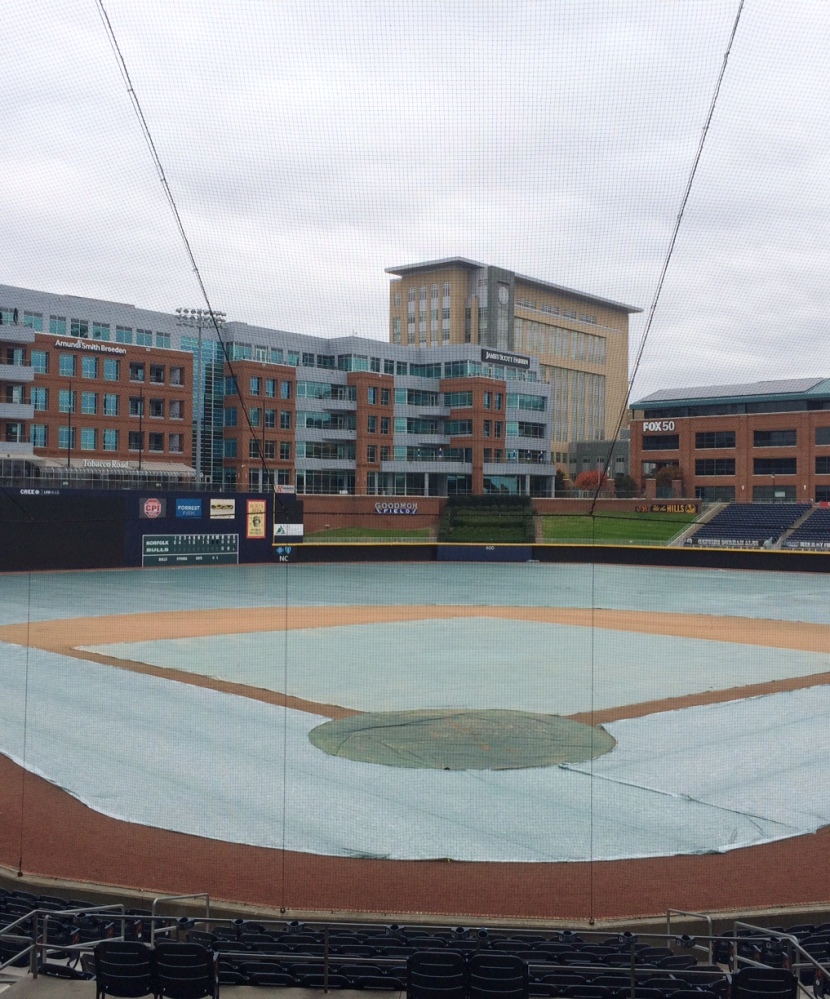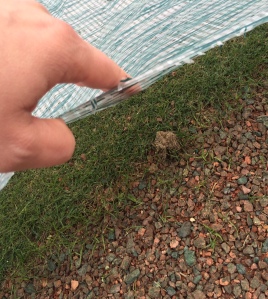Tagged: Groundskeeper

DBAP Grass Under Wraps
If you’ve been by the ballpark recently (or viewed our stadium webcam), you’ve noticed something different about the grass. A year after the field was completely replaced, you might be thinking, “what now?” There’s no better man to answer that question than the DBAP’s Head Groundskeeper Scott Strickland. So, we at Hit Bull Win Blog have relinquished the reigns to our intrepid turf manager for a guest post. Take it away Strick…
 In the first 3 months of the 2015 season, the DBAP playing surface will host 23 Bulls games, 15 ACC Baseball Championship games, 9 Duke University Baseball games, and the Duke University Class of 2015 will graduate on it. Simply put, there is no other facility in the country that will host that many events in that short of a period. This is a stat we are proud of and one that comes with operating the premier Minor League Baseball stadium in the country. However, it’s also a stat that makes growing grass about as easy as hitting an Aroldis Chapman fastball. To accomplish our goals, we must change how we maintain our surface. The following is how we will hit that fastball off the Bull and win a steak.
In the first 3 months of the 2015 season, the DBAP playing surface will host 23 Bulls games, 15 ACC Baseball Championship games, 9 Duke University Baseball games, and the Duke University Class of 2015 will graduate on it. Simply put, there is no other facility in the country that will host that many events in that short of a period. This is a stat we are proud of and one that comes with operating the premier Minor League Baseball stadium in the country. However, it’s also a stat that makes growing grass about as easy as hitting an Aroldis Chapman fastball. To accomplish our goals, we must change how we maintain our surface. The following is how we will hit that fastball off the Bull and win a steak.
The 2014 season brought exciting changes to 409 Blackwell Street. A ballpark that had served a community well for almost 20 years was spruced up for the next 20 years. Additional picnic areas, a completely new to the ballpark club area, additional concession stands and points of sale, drastically improved high definition video boards, a state-of-the-art sound system, and new field lighting highlighted the improvements made which hopefully were experienced by each of the 533,033 fans who entered the DBAP in 2014. Included in the renovation was the removal of our playing surface and the installation of a new surface to serve our users for the next 20 years. Unlike when the DBAP opened in 1995, our users are no longer just the Bulls and the opponent’s players. They aren’t even just baseball teams anymore. Concerts, graduations, weddings, beer festivals, 5k’s, strawberry festivals, Cub Scout sleepovers, and even yoga workouts makeup our user groups and event schedule now. We literally can go from having the top prospects from the Yankees or Red Sox battle our Bulls one night, to cleaning up a scout sleepover the next morning to get ready for the 5k that night.
In order to provide all of our users the experience they expect and demand, we as a grounds crew have to have the ability to change. We have to be flexible in our maintenance practices to make sure the next Derek Jeter doesn’t catch a ground ball to the face because Suzie’s yoga mat was left on the grass too long. In order to accomplish that goal for 2015, we have made radical changes to our maintenance strategy consisting of practices that have never been done before at the Triple-A level.
Durham, North Carolina sits in an area of the country that is known as the Transition Zone in the turf industry. Our climate isn’t warm enough to grow warm season turf year round, nor are we in an area that is cool enough to grow a cool season turf year round. In order to grow grass during the summer months, we install a hybrid Bermuda called Tifway 419. This turf goes dormant once the first hard frost sets in, usually around mid-November in the Raleigh-Durham area. If you are a golfer, you are familiar with how this affects turf throughout the year. The golf course turns brown, which is generally thought of as unattractive and doesn’t regain its green color and growth until the spring. Most courses then overseed their tee boxes and other areas of the course they want to keep green throughout the winter with a perennial ryegrass product. Traditionally, we are no different. We overseed the entire playing field and rely on that ryegrass to serve as our green color from the fall through our college games in March and overlapping into the Bulls schedule through May. The downfall to this strategy is ryegrass cannot survive in the summer heat. Once temperatures reach 80 degrees and more, the grass starts to die off. If you are a Bulls season ticket holder and are able to come to a lot of games, you probably have noticed how the turf appears worn out and in rough shape around late June and into July. This is caused by the ryegrass dying and the Bermuda grass trying to take over.
Year after year, baseball diamonds in our area of the country battle this transition process. It is the most difficult part of a groundskeeper’s year. Some years it is unnoticeable from the stands or even from the players playing on the surface. Some years it is extremely noticeable and can lead to playability issues.
 As much as raking dirt and mowing grass is a part of a MiLB groundskeeper’s responsibilities, so is keeping up with industry standards and advancements. Advancements in the use of turf colorants, combined with grow blankets, have shown drastic results in how long facilities can keep their warm season Bermudagrass green and still maintain a safe and aesthetically pleasing playing surface. Instead of overseeding their turf, facilities are electing to paint the turf green and keep the soil profile warm with grow blankets, thus eliminating the need for the ryegrass. The transition never happens and the turf is much more consistent throughout the year. We have kept up with these advancements and seen other facilities show great success with the strategy.
As much as raking dirt and mowing grass is a part of a MiLB groundskeeper’s responsibilities, so is keeping up with industry standards and advancements. Advancements in the use of turf colorants, combined with grow blankets, have shown drastic results in how long facilities can keep their warm season Bermudagrass green and still maintain a safe and aesthetically pleasing playing surface. Instead of overseeding their turf, facilities are electing to paint the turf green and keep the soil profile warm with grow blankets, thus eliminating the need for the ryegrass. The transition never happens and the turf is much more consistent throughout the year. We have kept up with these advancements and seen other facilities show great success with the strategy.
Many golf course superintendents are starting to not overseed their courses for the same reasons. Pinehurst recently made news in the golf world by announcing they will not overseed any parts of any course for 2015. Major League Baseball teams such as the Atlanta Braves, New York Yankees, and Boston Red sox are now covering their fields with growth blankets to keep their turf warm and protected from the winter conditions. Colleges in the ACC and SEC are adopting these same maintenance techniques to keep their baseball and football fields shining on national television. All of these facilities are showing radical change in order to provide their users the best possible conditions. If it’s good enough for Pinehurst Number 2, the Atlanta Braves, New York Yankees, and the Boston Red Sox, it’s good enough for the Durham Bulls.
 If you stop by the DBAP this winter you will see the effects of us joining those facilities in how they maintain their fields. In mid-October, we painted the field with a turf colorant and followed the application with installing our grow blankets. The blankets are a green lightweight material that allows air, water, and light to penetrate below to the grass. It will raise the soil temperature by 10 to 12 degrees and will protect the turf from frost. Much as you probably love to curl up under a blanket on a cold winter day, these turf blankets allow our grass to do the same. Our goal is simple: We want to remove the blankets prior to the start of baseball season in mid-March and our Bermudagrass still be green. If all goes according to plan, our fans and players will never know a difference on April 15th at 7:05pm when the first pitch of the 2015 season is thrown.
If you stop by the DBAP this winter you will see the effects of us joining those facilities in how they maintain their fields. In mid-October, we painted the field with a turf colorant and followed the application with installing our grow blankets. The blankets are a green lightweight material that allows air, water, and light to penetrate below to the grass. It will raise the soil temperature by 10 to 12 degrees and will protect the turf from frost. Much as you probably love to curl up under a blanket on a cold winter day, these turf blankets allow our grass to do the same. Our goal is simple: We want to remove the blankets prior to the start of baseball season in mid-March and our Bermudagrass still be green. If all goes according to plan, our fans and players will never know a difference on April 15th at 7:05pm when the first pitch of the 2015 season is thrown.
See you at the DBAP in 2015.
Scott Strickland has served as the Head Groundskeeper at Durham Bulls Athletic Park for the last ten seasons. He enjoys being literal in speech and the written word, loves answering questions about impending rain, and is a traditionalist when it comes to putting patterns into the field. You can follow him on Twitter @DurhamBullsTurf at your own peril.